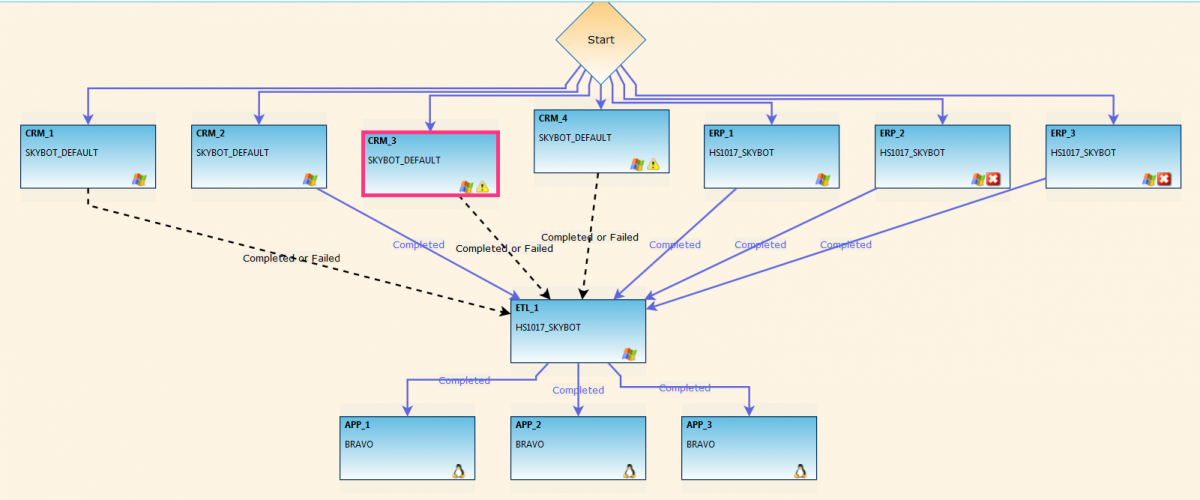Backup plans: they’re important. “Better safe than sorry,” we’ve all heard. That’s why you have more than one credit card. That’s why you fill up your gas tank when the thermometer drops below 15 degrees in January. That’s why—as a principle—you keep two flavors of ice cream on hand at all times. It’s just that important to cover your bases, to have a backup plan.
Is your enterprise job schedule as safe as the rest of your life? What happens if there are changes to the schedule? How can exceptions be handled automatically and easily within the schedule? The ability to set up alternate reactive paths could be the backup plan you’re looking for.
Make Your Job Schedule Smarter
Ultimately, the ability to build alternate reactive paths is borne out of the understanding that you can never have complete control of everything happening in your network. You’ve done your due diligence to secure your network and establish high availability options, but what will happen if an important part of your job fails because of an unexpected external occurrence? If you have errors in a job stream, is it okay to skip over that step, or is it critical that that step gets run and re-processed? Or what if it’s as simple as an Internet outage in your network and you can’t see a remote office? You want your software to behave as best it can no matter what the circumstance.
With alternate reactive paths, you can build known solutions into your job suites. If the job works successfully, the job suite continues in one direction. If the job happens to fail, it will go a different direction to complete a pre-determined solution before continuing on in the job suite. What’s important here is that, to set up alternate reactive paths, you know it’s a job that either always fails or sometimes fails and you know in what specific way that it will fail. You also need to understand the requirements for each job. Armed with this information, you’re able to include the known, effective solution for that particular failure in the job suite.
Thus, alternate reactive paths are not necessarily a feature you’ll utilize with every job you’re going to schedule. Rather, you will set up alternate reactive paths at the job level when you know it’s an error-prone job stream.

Build a Degree of Fault Tolerance
Because you can never control everything—no matter how much we’d like to be able to—alternate reactive paths allow you to build a degree of fault tolerance. In the past, with Automate Schedule, you could only react to a completed status on a completed job. Now, with Automate Schedule, you can react to different dependency options. When you’re setting up your job suites, you can choose from “completed,” “failed,” or “completed or failed”. Automate Schedule requires that you delineate what a completed or failed job looks like, and the general mechanism for allowing Automate to know whether it’s a failure or not is something in the log or standard output.
For example, if the agent completes a job and the server connection is unavailable, the agent will not just throw the job away. Instead, it puts the job history onto a little queue and waits until the agent reconnects to the server. Though the job didn’t get set up right away in this scenario, it does get sent out eventually. The ability to build this type of flexibility lets you trust that your enterprise job schedule has your back—and your backup plan—in its best interest.
The other way in which alternate reactive paths help you build an extremely flexible job schedule is that they can account for partial job failures. For example, if a job was meant to update all of your database records and the job only updates some of the records, the job would be partially completed. You can build an alternate reactive path to complete the job fully before launching the next step in the job stream.
Hope for the Best—Prepare for the Worst
Enterprise job schedulers are there to make your life easier and building alternate reactive paths only gives you more flexibility for your job schedule. If you’re already relying on an enterprise job scheduling tool to make your enterprise more efficient, you’d likely benefit from additional error reporting and exception handling offered by this new functionality in Automate Schedule. So whether you’re building job streams for month-end processing, CRM processing, or order and payment processing, you’re likely dealing with very specific output files and pre-requisites, which would make these job streams a strong candidate for alternate reactive path processing.
Make your job schedule as smart as possible with Automate Schedule's new feature. You can learn more about setting up alternate reactive paths in Automate Schedule in this recorded webinar. If you want to experience the value of setting up an event-driven job schedule, start a free trial of Automate Schedule today.